Destination Duluth
The summer of 2017 has been quite busy for yours truly. Having captured my first U.S. Senior title at the end of July, in August I hit the chess trail like it’s 1995 over again. That memorable year I crisscrossed the country high and wide, played almost 200 tournament games, and nearly drove (pun intended) myself to exhaustion.
I hope I’m not foolish enough to repeat this experience 22 years later. Yet, in the second weekend of August my wife and I took a trip up north to the southern shores of Lake Superior. The largest of the five Great Lakes, it has the size of an inland sea and therefore creates its own microclimate.
The cool breezy summer nights offer a much-needed respite to the heat-weary Midwesterners. So, they pack their cars and trucks, campers and trailers and head up north on I-35. Some 150 miles from Minneapolis they reach their destination.
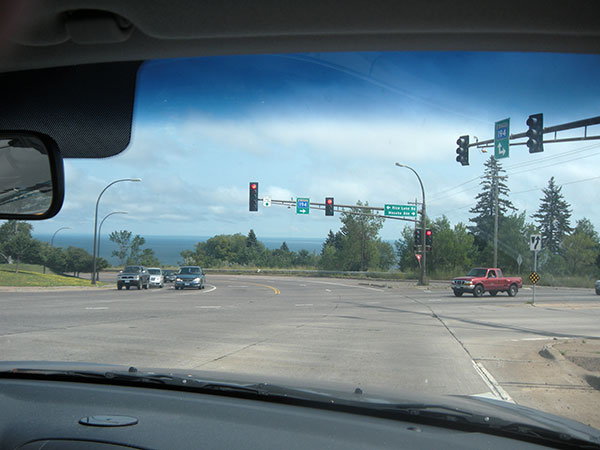
Coming to Duluth

The panoramic view of the lake gives a dramatic backdrop to Duluth's hilly streets
The first five editions of the Twin Ports Open were held in downtown Duluth, next to the famous Lift Bridge, a popular tourist attraction.

This is not a drawbridge, this whole section of the roadway actually goes up to allow boats to come through, then lowers back again to let the cars drive across.
The tournament site was The Suites, where we played in 2012-2016. Great views and nice restaurants all about, the hustle and bustle of the touristy area was not an ideal location for a chess tournament. So, in 2017 the Twin Ports Open moved over the state line to the Barker Island Resort in Superior, Wisconsin.
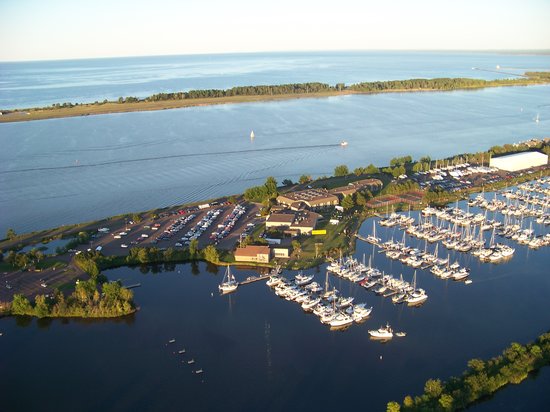
Aerial view of Barker's Island
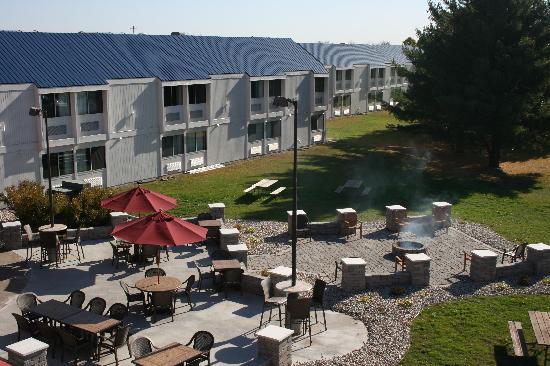
In the summer, it becomes one of the area's vacation hotspots
The principal men behind the event are the “Dane Brothers”, Dane Mattson and Dane Zagar, who are very active in the area’s chess community. Being modest men, they didn’t allow their pictures to be taken, but they can be found on the group photo below (tall young dudes with glasses).
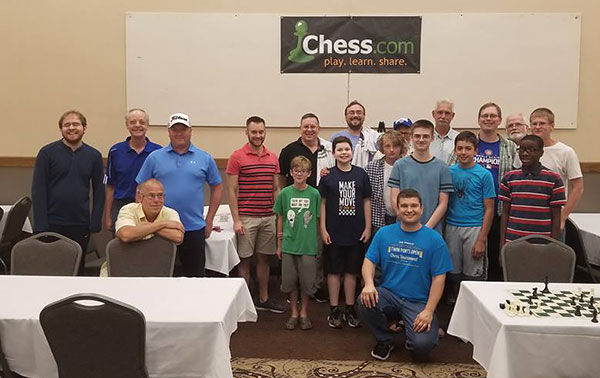
The event kicked off Friday night with a special exhibition game of Chess960. Both IM John Bartholomew and I had a team of consultants to help us, while NM Mike Zaloznyy of Las Vegas, Nevada graciously agreed to serve as the runner, bringing moves from my room to John’s and back. It was an interesting game, and I wish I had a score of, but ultimately it was taking a bit too much time and by agreement it was decided in a blitz battle between selected representatives. In a huge time scramble John’s guy checkmated my guy, but there were smiles all around.
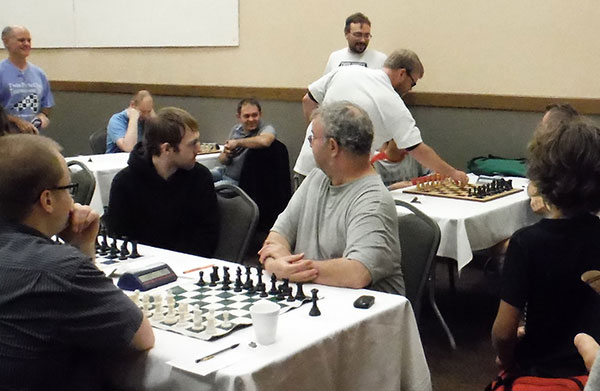
Somehow the Danes were able not only to secure a prime location at the yachting resort, but even had the city's Mayor Jim Paine greet the players and make a ceremonial first move!
Our family duo were the joint winners in 2016, but this year both Camilla and I had to take a backseat to more motivated players.

WGM Camilla Baginskaite, wife and partner
Camilla didn’t deem any of her efforts worthy of publishing, so I’ll start with a game of my own against the above mention Mike Zaloznyy.


[Event "Twin Ports Open"] [Site "?"] [Date "2017.08.12"] [Round "2"] [White "Yermolinsky, Alex"] [Black "Zaloznyy, Mike"] [Result "1-0"] [ECO "A84"] [Annotator "AlexYermo"] [PlyCount "43"] [EventDate "2017.??.??"] {Unlike last year when Mike and I played the last-round money game, this time we meet early in the tournament.} 1. Nf3 e6 2. g3 b6 3. Bg2 Bb7 4. O-O Be7 5. c4 f5 {This is known to be an unhealthy mix of systems.} 6. Nc3 Nf6 7. d4 { Clearly White is aiming for d4-d5.} Ne4 8. Bd2 {A somewhat reserved choice, as Black is given a chance to transpose into a theoretical line of the Queens Indian Defense.} ({Instead, the forceful} 8. Nxe4 $1 Bxe4 ({In case of} 8... fxe4 9. Ne5 d6 {the clever move} 10. Nd3 $1 {rescues that knight from oblivion. }) 9. d5 O-O 10. Bh3 $1 {is promising for White, e.g.} Qe8 11. Nd2 Qh5 12. Nxe4 Qxh3 13. Nc3) 8... Bf6 9. Qc2 Qc8 $2 {A novelty, and an unfortunate one at that. As a rule, before attempting to build the battery on the long diagonal Black should first make sure it stays obstacle-free.} (9... O-O 10. Rad1 Nxc3 11. Bxc3 Be4 12. Qb3 d6 13. Ne1 $14) 10. d5 {Obviously.} Nxc3 $6 {Very accommodating.} ({The objectively best} 10... Nxd2 11. Qxd2 O-O {White can meet with the energetic} 12. e4 $1 Bxc3 13. Qxc3 fxe4 14. Ng5 exd5 15. cxd5 Bxd5 16. Nxe4 Bxe4 (16... c6 17. Nd6) 17. Bxe4 c6 18. Qd3 h6 19. Bd5+ Kh8 20. Bb3 {but, still, those lines are way more challenging for White to come up with.}) 11. Bxc3 O-O 12. Rad1 $16 {[#] Without any real effort White got himself a very pleasant position. It is up to Black to do something, and Mike is trying to break out.} c6 13. dxe6 dxe6 14. Bxf6 gxf6 (14... Rxf6 15. Ne5 c5 16. Rd6 $18 {permanently keeps Nb8 out of commission.}) 15. Rd6 ({The same strategy of restricting the black knight I could have followed with} 15. Nd4 $1 Na6 16. a3) 15... c5 16. Rfd1 Nc6 17. Qd2 Rd8 {Mike is trying to do the right thing by challenging for the d-file.} (17... Qe8 18. Qe3 Rd8 19. Nh4 $16) 18. Qh6 $6 {I just couldn't resist the temptation.} ({The simple} 18. Qe3 {would suffice.}) ({but the best was} 18. Nh4 Qc7 19. Rd7 Rxd7 20. Qxd7 $18) 18... Qc7 {[#]} 19. Ng5 $1 {It was about this flashy move.} Nd4 $2 ({Black would do his best by not trying to refute White's play tactically. Say, he follows along with} 19... fxg5 20. Qxe6+ Qf7 21. Qxf7+ Kxf7 22. Bxc6 Rxd6 23. Rxd6 Bxc6 24. Rxc6 {[#] Alright, he's down a pawn now, but rook endgames can be defended even against greater odds.} Rd8 $1 25. Rc7+ Kg6 26. Rxa7 Rd2 27. b3 Rxe2 28. Ra6 Re6 29. a4 Kf6 30. f4 gxf4 31. gxf4 Ke7 {It isn't clear how White is going to make any progress.}) 20. R1xd4 $1 cxd4 21. Nxe6 {I thought the game was already over.} Qe7 22. Nxd8 1-0
The Queen's Indian Defense is one of the most solid and rich openings against 1.d4. Together with the Nimzo-Indian and the Catalan it forms the so called "Classical Setup", which any player should know. Victor Bologan calls the b7 bishop “the soul of the opening, the most important piece...keep it active”. Every chess enthusiast, from beginner to high level player, can profit from this DVD. Enrich your chess vocabulary, be open to new ideas: play the Queen’s Indian!
The brutal schedule of weekend tournaments now calls for three games on Saturday and two more on Sunday. Combined with the travel, it makes for a kind of weekend you’ll need two more weekends to recover from.
I felt pretty beat up toward the end of Saturday sessions and took a side of caution against young Iowa State Champion NM Daniel Brashaw. An uneventful draw left us at 2.5/3 while the competition was pulling away.
The following morning I played a critical game against GM Bryan Smith of Philadelphia. Getting a second black in a row was not anticipated, but Bryan’s perfect score up to that point made him due for white.


[Event "Twin Ports Open"] [Site "?"] [Date "2017.08.13"] [Round "4"] [White "Smith, Bryan"] [Black "Yermolinsky, Alex"] [Result "1/2-1/2"] [ECO "B12"] [Annotator "AlexYermo"] [PlyCount "177"] [EventDate "2017.??.??"] 1. e4 c6 2. d4 d5 3. e5 c5 4. dxc5 e6 ({I don't particularly like Black's position in the alternative line,} 4... Nc6 5. f4 e6 6. Be3) 5. a3 Bxc5 6. b4 ( {Not much is accomplished by} 6. Qg4 Ne7 7. Qxg7 Ng6) ({However,} 6. Nf3 Ne7 7. Bd3 Ng6 8. O-O Nc6 9. b4 Bb6 10. Bb2 Nf4 11. c4 {Karjakin-Topalov, 2017 remains White's top choice.}) 6... Bf8 $5 {An over-ther-board inspiration. I wanted to keep the b6-square open for my other bishop's fianchetto.} (6... Bb6 7. Qg4 Ne7 8. Nf3 Ng6 9. Bb2 $14) 7. Nf3 a5 8. b5 Nd7 9. c4 {Bryan resorts to White's standard plan in such positions.} (9. Be2 Ne7 10. O-O Ng6 11. Bb2 Qc7 ( {Perhaps,} 11... b6 {again.}) 12. c4 $1 dxc4 13. Nbd2 Ngxe5 14. Nxe5 Nxe5 15. Rc1 $44) (9. Bd3 Ne7 10. O-O b6) 9... Ne7 10. Bb2 {I was relieved to see this.} ({The more energetic} 10. Nc3 {would have required a careful handling:} dxc4 11. Ne4 Ng6 12. Bb2 (12. Nd6+ Bxd6 13. exd6 O-O 14. Bxc4 Nb6 15. Ba2 Nd5 { not dangerous at all.}) 12... b6 13. Bxc4 Bb7 {etc.}) 10... b6 11. Nbd2 Bb7 { [#]} 12. h4 $5 {A very typical move for Bryan Smith's creative style of play.} (12. cxd5 Nxd5 {would greatly help Black.}) ({While} 12. Rc1 Nc5 13. Be2 Ng6 14. O-O {lows Black to position his pieces in a harmonous way.} Be7) 12... Nc5 13. h5 Nf5 14. Nd4 {It took Smith a long time to settle on this.} (14. g4 Nh6 15. Rg1 Be7 {must have felt too loose.}) 14... Nxd4 (14... Qg5 $1 15. N2f3 Qf4 16. Nxf5 Qxf5 {would have given Black a great position.}) 15. Bxd4 h6 $2 { Very wrong.} ({I realized my queen needed to come out to interfere with White's kingside ambitions, but} 15... Qg5 $1 16. Nf3 Qf5 {was a bit unnerving. In reality, White can do no harm to the black queen:} 17. Bxc5 (17. Rh4 dxc4) 17... Bxc5 18. Bd3 Qf4 19. Rh4 Qh6 $15) 16. Rc1 Be7 $2 {Another meek move.} ( 16... a4 $1 17. Rh3 Nb3 18. Nxb3 axb3 19. Rxb3 Bxa3 20. Ra1 Be7 {would have provided the necessary distraction.}) 17. Qg4 O-O 18. Rh3 {[#] Facing White's first threats I collapse immediately.} Ne4 $2 ({Despite its ugly appearance} 18... Kh8 19. Rg3 Rg8 {was quite playable.}) ({The line I was looking at was} 18... f5 19. exf6 Bxf6 20. Bxc5 bxc5 21. Bd3 {and here only} Bg5 $1 22. Qxe6+ Kh8 23. Qg6 Qe8+ 24. Re3 $1 Qxg6 25. Bxg6 Bxe3 26. fxe3 Rad8 27. Ke2 d4 28. Nb3 Bxg2 29. Nxc5 dxe3 {maintains the dynamic balance.}) 19. Nxe4 dxe4 20. Rd1 Qc7 ({Unsatisfactory is} 20... Kh8 21. Rg3 Rg8 22. Qf4 Qf8 23. Qe3 $16) 21. Rg3 Bg5 22. Be3 {I missed this simple idea.} ({Somehow my plans revolved around} 22. f4 exf3 23. gxf3 f5) 22... Qxe5 (22... Rad8 23. Bxg5 Rxd1+ 24. Kxd1 hxg5 25. Qxg5 Qd8+ 26. Qxd8 Rxd8+ 27. Kc2 $18) 23. Bxg5 hxg5 24. Qxg5 Qxg5 25. Rxg5 Rfd8 26. Rxd8+ Rxd8 27. c5 {[#] Just like that I arrived in a bad ending.} Bd5 28. cxb6 {For a long while Bryan's play remains precise.} ( 28. c6 Kf8 $16) 28... Rb8 29. Kd2 Rxb6 30. Kc3 Rb8 31. Kd4 Kf8 (31... Rc8 32. b6 Rc6 33. Rxd5 exd5 34. b7 Rb6 35. Ba6 $18 {is the point.}) 32. Bc4 Ba8 $138 { I was down to the increment alone.} (32... a4 33. Rg3 f5 34. Rc3 {still looks quite bad for Black, though.}) 33. Rc5 Rd8+ 34. Ke3 Ke7 35. b6 Rb8 36. Rxa5 Bc6 37. Ra6 $2 {Time trouble} ({Driving the black king away would have sealed the deal:} 37. Ra7+ Kf6 38. Ra6 $18) 37... Kd6 38. Ra7 {[#] The beginning of a time scramble that would last 50 moves.} Bb7 $2 ({Black can still resist after the correct} 38... Bd7) 39. Ba6 $2 (39. a4 Kc5 40. Ba6 $18) 39... Bd5 { preferred a technical solution} 40. b7 ({over the objectively better} 40. Rxf7 Rxb6 41. Be2 Rb3+ 42. Kd2 Rb2+ 43. Kd1 e3 44. fxe3 Bxg2 45. Rxg7 Be4 {There's no way Black should be able to save it.}) 40... e5 41. g4 f6 42. Ra8 Rxa8 43. bxa8=Q Bxa8 44. Bc8 Bc6 45. Bf5 Kc5 46. Bxe4 Bd7 47. Bf5 Bc6 48. Be6 Kd6 49. Bb3 Kc5 50. Bd1 Kc4 51. f4 exf4+ 52. Kxf4 Bd7 53. Bc2 Kd4 54. Bf5 (54. a4 Kc3 55. a5 {wins. Later he used the same idea.}) 54... Ba4 55. Be6 Kc3 56. Bc8 Bc2 57. Bd7 Kc4 58. Be8 (58. a4 Kb4 59. Ke3 $18) 58... Kc5 59. Bg6 Ba4 60. Bd3 Kd4 61. Be2 Bd7 62. Bd1 Kd3 63. a4 $1 {[#] Finally!} Kd2 64. Bb3 ({Too early for} 64. a5 Kxd1 65. a6 Ke2 66. a7 Bc6 67. Kf5 Kf3 $11) 64... Kc3 65. a5 $1 Bc8 66. Bd1 Kd2 67. Bf3 Kd3 68. Bg2 Kd4 69. Bf1 Kc5 70. a6 Kb6 71. Be2 Be6 72. Bd3 Bc8 73. Bc4 Bd7 74. Bd3 Bc8 75. Be2 Bd7 76. Ke4 Be6 77. Kd4 Bb3 78. a7 $1 Kxa7 79. Kc5 Bc2 80. Kd6 Kb6 81. Bc4 $6 {What for?} ({There was no need for fancy footwork when} 81. Ke7 {does it}) 81... f5 82. g5 f4 83. Be2 Be4 84. Ke5 (84. g6 f3 85. Bxf3 Bxf3 86. h6) 84... f3 (84... Bc2 85. h6 gxh6 86. gxh6 Kc7 87. Bf3 Kd7 88. Be4) 85. Bf1 $4 {Finally, this endless screwing around in a simple ending came back to bite Bryan.} (85. Bxf3 Bxf3 86. h6 {queens}) 85... Bc2 $11 86. Ke6 Bb3+ 87. Ke7 f2 88. Kf8 Bd1 89. Kxg7 {What a strange game.} 1/2-1/2
I can imagine how Bryan must have felt after the game. Yet, one doesn’t get to grieve too long in American open tournaments. Less than ten minutes later we sat at the board again for our Round Five games.
I struggled somewhat against NM Wilson Gibbins’s Accelerated Dragon, but ultimately was able to prevail. We joked that something felt odd about this game, as in all previous events we always played each other in Round Two, and Wilson had White!
In the meantime, the big battle was fought on Board One.
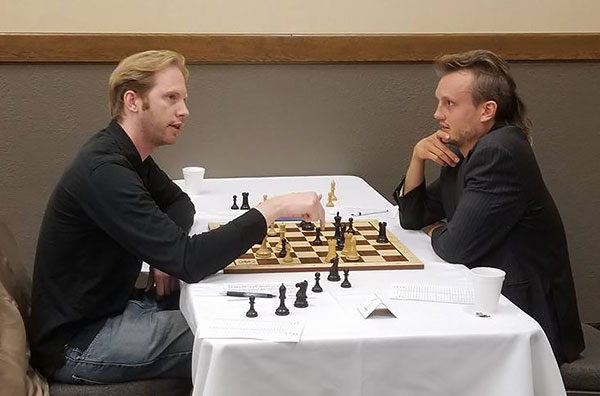

[Event "Twin Ports Open"] [Site "?"] [Date "2017.08.13"] [Round "5"] [White "Smith, Bryan"] [Black "Gareyev, Timur"] [Result "1-0"] [ECO "C93"] [Annotator "Yermo"] [PlyCount "97"] [EventDate "2017.??.??"] 1. e4 e5 2. Nf3 Nc6 3. Bb5 a6 4. Ba4 Nf6 5. O-O Be7 6. Re1 b5 7. Bb3 d6 8. c3 O-O 9. h3 Bb7 10. d4 Re8 11. Ng5 Rf8 12. Nf3 {An interesting ploy. Perhaps, exhausted by its length and surely frustrated by the outcome of our game, Bryan Smith didn't mind a draw to wrap up the tournament.} h6 {The ever-combative Gareyev emphatically states his desire to play for a win.} 13. Nbd2 Re8 {Now they're back in the old Smyslov line, where White has the time for an important knight transfer.} 14. Nf1 $1 {The e4-pawn is safe.} Bf8 15. Ng3 Na5 16. Bc2 Nc4 17. b3 Nb6 18. a4 bxa4 ({For a few games GM Ivan Sokolov experimented with} 18... d5 {which in past was played by old Yugoslav greats Gligoric and Ivkov. White does get a better game after} 19. Nxe5 dxe4 20. Bf4 ( 20. Qe2 b4 $1) 20... Nbd5 21. Bd2 b4 22. c4 Nc3 23. Bxc3 bxc3 24. Nxe4 Bxe4 25. Bxe4 Nxe4 26. Rxe4 f6 27. Nc6 Qd7 28. Rxe8 Rxe8 29. Qf3) 19. bxa4 a5 20. Bd3 { [#]} Qc8 {Not a novelty, just a rare move.} ({Most people had preferred to trade light-squared bishops:} 20... Ba6 21. Bxa6 Rxa6 22. Qd3 Ra8 23. Be3 $14) ({An old classic is Anand-Kamsky, Linares 1991, which saw} 20... Bc6 21. d5 Bd7 22. Bb5 Bxb5 $2 {Question mark by Anand.} 23. axb5 $16 {In his notes Vishy was already talking about White's advantage being near decisive.}) 21. d5 Ba6 22. Bb5 Nfd7 23. Nf5 Bxb5 24. axb5 Nc5 {[#] This is a little sharper version of the above mentioned game, Black is threatening to undermine the f5-knight, and counts on developing some counterplay.} 25. Nh2 $5 {Very much Bryan's style. He values attacking chances against the king above all other positional factors.} (25. Qc2 a4 26. c4 h5 {preparing to evict the knight by g7-g6.}) 25... Nxe4 {Timur accepts the challenge.} ({Rather than allow White a dangerous build-up on the kingside after:} 25... a4 26. Qh5 Nd3 27. Ng4) 26. Nxh6+ gxh6 27. Rxe4 f5 28. Rh4 Qd8 29. Rh5 Qf6 30. Qf3 f4 31. g3 (31. Qe4 Qf7 32. Ng4 { seems strong, but somehow Black manages to hold everything after} Kh8 $1 33. Rh4 h5) 31... Bg7 32. Ng4 Qg6 33. Rh4 (33. gxf4 exf4 34. Bxf4 Rf8 35. Rh4 $13) 33... h5 $6 (33... e4 $1 34. Qxf4 h5 {was a better interpretation of the same idea}) 34. Rxh5 e4 35. Qd1 e3 36. fxe3 fxg3 {[#]} 37. e4 $1 {Pawns don't count around here, development is the name of the game.} Qxe4 (37... Rxe4 38. Rg5 $18 ) 38. Be3 Nc4 39. Bd4 Ne5 $2 {This turns out to be a big time positional concession.} ({Instead, a cool defense} 39... Qg6 40. Bxg7 Kxg7 41. Qd4+ Ne5 42. Rh4 Qd3 {would take the game into a rook ending,} 43. Nxe5 Qxd4+ 44. cxd4 dxe5 45. Rg4+ Kh6 46. Rc1 Rad8 {which, as many of those tend to go, would end peacefully.}) 40. Bxe5 dxe5 ({Of course not} 40... Bxe5 41. Rxe5 {Perhaps Gareev misssed that.}) 41. Ra4 $1 {A dramatic second rook lift all but seals the deal.} Qg6 42. Nh6+ Kf8 43. Qf3+ Bf6 44. Rg4 Qb1+ 45. Kg2 Ke7 46. d6+ $1 Ke6 47. d7 Qxb5 48. dxe8=Q+ Rxe8 49. Rg6 1-0
A great tournament for Bryan, who took his victory lap the next day, giving a simul to the local players.
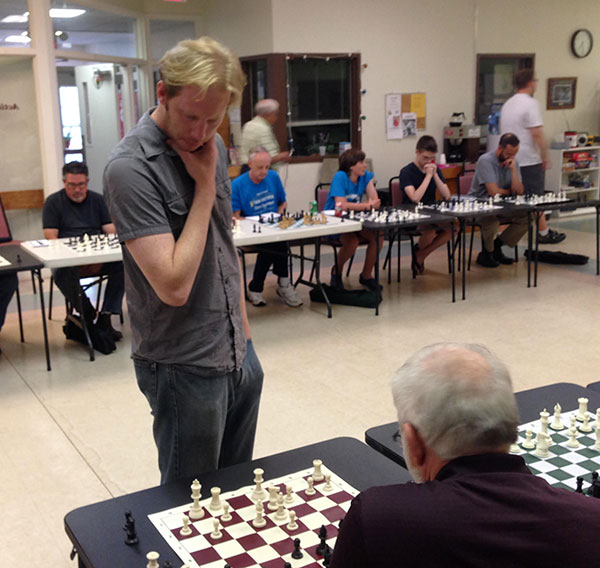
GM Bryan Smith, the tournament winner, gives a simul to the locals
Final Standings
1. Smith 4.5
2-4 V. Georgiev, Bartholomew, Yermolinsky 4
5-12. Gareev, Baginskaite, Brashaw, Wasiluk, J. Neal, Fellman, Drake, Matus 3.5
I just managed to get to the winners podium together withh Vladimir Georgiev and John Bartholomew, who took half-point byes to accommodate their busy schedules. In the meantime, Timur Gareyev, who spent the entire tournament on board one came away empty-handed. However, he will be featured in the next episode of my travelogue, titled “In The Iowa Wetlands”. Stay tuned!




































